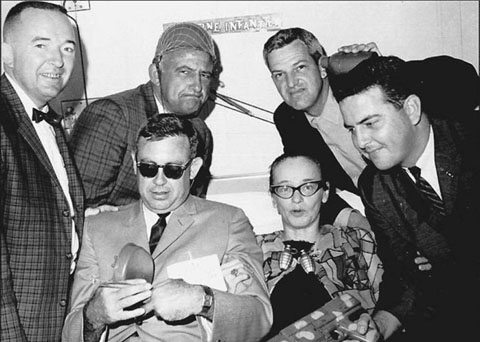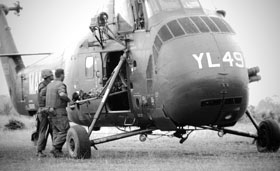Leatherneck and the CCs: A little history

Marine Combat Correspondents gather at the bedside of Dickey Chapelle, recovering from a parachuting accident in a New York hospital, in 1964. (L-R) Maj. Bob “Mo” Morrisey, Lou Lowery, Dick Phelan, Steve Stibbens, and Ron Lyons seated with Dickie. Lowery, Lyons and Stibbens were were all members of the Leatherneck Magazine staff. The following year, Chapelle went to Vietnam to be with her beloved Marines in combat.
By Bob Bowen
Author, “My Life and Lens, the story of a Marine Corps Combat Correspondent”
The Marine Corps Combat Corespondents Association had its origins in World War Two. Following that war, the group was held together in an informal way through the volunteer efforts of Gladys McFarland of the Marine’s New York Information Office and the civilian staff at Leatherneck Magazine.
Col. Don Dickson, Editor-Publisher of Leatherneck, along with director of photography Lou Lowery, the Marine who made the first photo of the flag raising on Iwo Jima, and Ron Lyons, assistant editor, were the principle supporters of the CC’s at the Magazine.

Dickey Chapelle was killed in November 1965 while covering Operation Black Ferret. Sgt. Frank Beardsley, Leatherneck Magazine Correspondent, was there and captured her final departure from the battlefield.
When the Marines landed in Vietnam in 1965, there was a renewed focus on the Corps’ informational services field and that spread to a rejuvenation of the CC’s. At HQMC, Maj. Bob Morrisey, CMC Wally Greene’s personal information officer, joined with McFarland and the Leatherneck stalwarts to encourage all Marine Corps writers, past and present, to join the loosely organized USMCCCA.
SSgt Steve Stibbens of Leatherneck Magazine was one of the first to heed the call. He joined the CC’s in 1964. Stibbens covered the Vietnam War first as a correspondent for the Pacific Stars and Stripes in 1962 and later for the magazine. And, after his discharge, the Associated Press.
In 1967, an all-out effort was made to celebrate the 25th anniversary of the CC’s. Leatherneck Magazine assumed the task of preparing the program for the Silver Anniversary gala gathering. Don Dickson and Ron Lyon put their heads together and wrote a history of the CC’s. Lou Lowery, then National President of the CC’s, searched magazine files for photos of CC’s in action in WWII and Korea. I was tasked with gathering photos of the latest CC’s from Vietnam.
As time went by, the USMCCCA took root throughout the United States. There were several name changes along the way. One time, to make photographers feel welcome, we added photographers to the title: USMCCCA&PA. Then, we added artists and the acronym grew: USMCCC, P&AA. That proved to be too cumbersome and in time the name shrunk to USMCCCA or simply CC’s.
Annual conferences were held, with an effort on getting max attendance from the active duty writers, photographers and artists. The Division of Information was active in this effort. It even organized Marine Corps flights to transport active duty CC’s to and from the annual conferences. There were pickup spots across the country. In 1971, the conference was held in San Diego and BGen Jay Hubbard, the Director of Information, piloted the plane.
Sally Pritchett and I were among those who got on the plane when it made its first pickup stop in Indianapolis. We were both assigned to the Defense Information School at the time and I was serving as President of the DINFOS Chapter of USMCCCA. I was also serving as National President Bob McEwen’s membership chairman. Six years later when the annual conference was held in D.C. I was stationed at the Pentagon as the Marine Corps spokesman. And, I was serving as President of the Jim Lucas Chapter of the CC’s.
Throughout its rebuilding years, Leatherneck continued to play a supportive role. Each annual conference received coverage in the magazine. The magazine sponsored awards, provided time for its members to serve as national officers, and had annual awards named after them. In addition, Lou Lowery and Tom Bartlett served as national presidents.